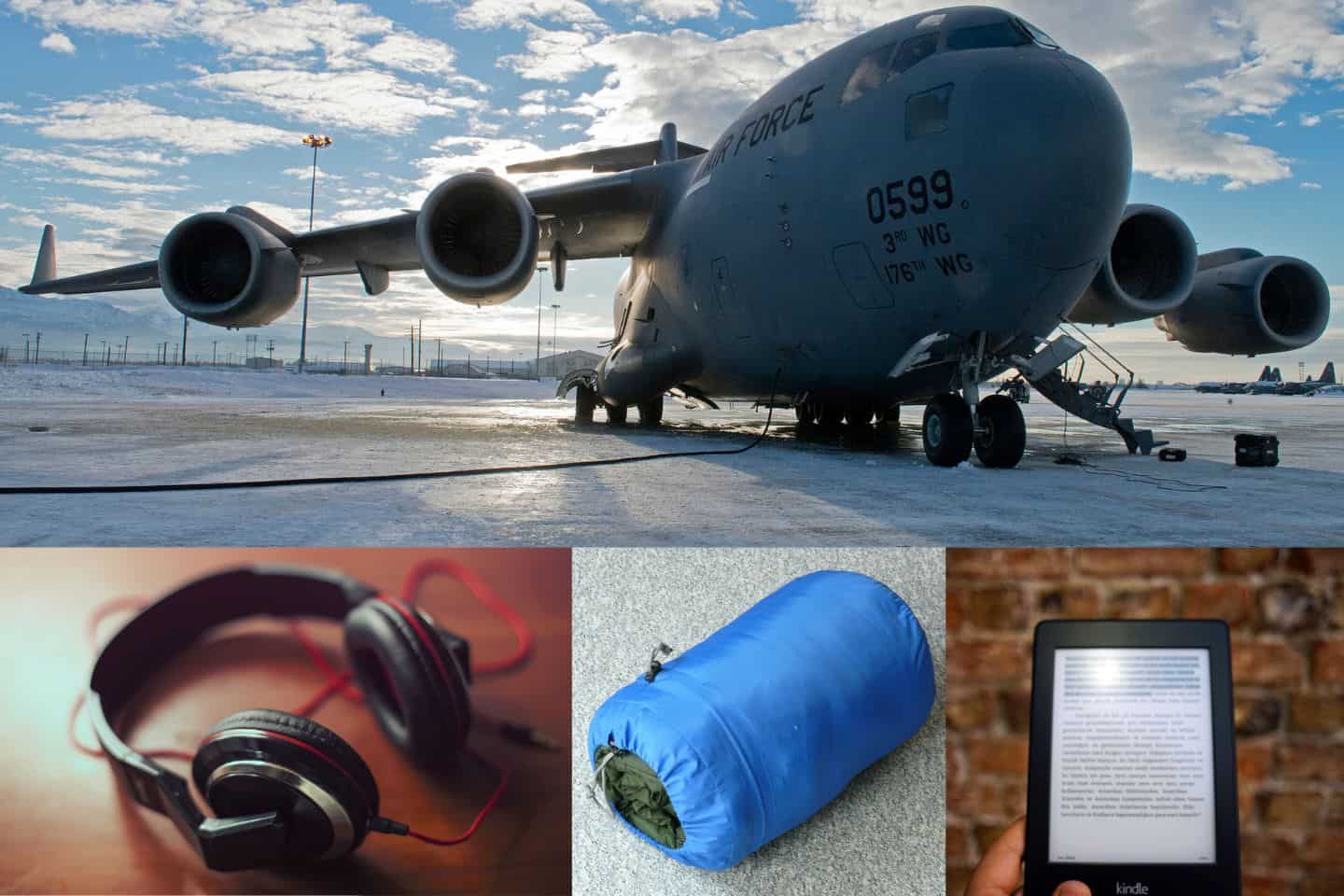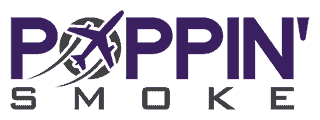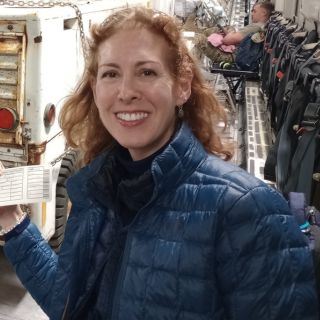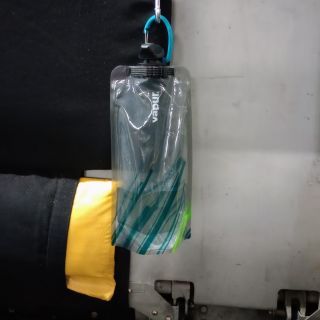
Getting ready to take a military hop? Make sure you have everything you need to stay comfortable, entertained, and travel-ready! Here’s how you can prepare for your next Space-A flight.
If you’ve never flown Space-A, read this Quickstart Guide to Military Space-A Flights to learn the process.
Documentation
Before going to the military passenger terminal, make sure you have proper identification and paperwork. Requirements depend on your Space-A category and reason for travel.
- Military ID: All travelers age 14 or older need a DoD uniformed services ID card. If you are traveling with children under 14 years old who do not have a military ID card, they must have a federal, state, local, or tribal government-issued ID.
- Passport: If you are traveling to/from another country, bring your passport. When visiting U.S. territories in the Pacific (e.g. Guam), you don’t need a passport, but it’s a good idea to bring yours, just in case. You may need to hop a flight via a foreign country. The same advice applies if you have a no-fee passport from an overseas duty station; bring a regular passport as well.
- Tourist Visa and/or Health-Related Documentation: If you plan to visit a foreign country during your travels, check to see whether you need a visa. Also, visit the website of the U.S. Embassy in your destination country to find out if they have any requirements for vaccines or pre-departure testing.
- Ordinary Leave or Environmental Morale Leave (EML) Form: Active duty travelers must bring the applicable form and supply it when marking themselves present.
- Unaccompanied Dependent Travel Memo: Dependents traveling without their sponsor must have authorization from their sponsor’s command. Click here for details and sample memos.
- Copies of Your Signup E-mails: The e-mails you sent to the passenger terminals serve as proof of the date and time of your signup. Most terminals will accept an electronic copy, but it doesn’t hurt to have everything printed out.
You may have other documentation requirements, depending on your status. See section 4.8 of DOD Instruction 4515.13 for a full list.
Checked Luggage
On most Space-A flights, passengers can check up to two bags weighing 70 lbs each.
Still, we recommend traveling light in case you have an opportunity to compete for a flight with weight restrictions or that can only accommodate passengers with carry-on luggage.
Also, we prefer to use luggage that meets the requirements for carry-on bags on most commercial flights in case we need to combine our Space-A travel with civilian air travel.
Here’s the suitcase I use and love. It’s extremely light, plus its spacious and expandable.
What to Wear on a Space-A Flight
The key to staying comfortable on a military flight is to dress in layers. Most military planes are quite cold, but the temperature varies, depending on the type of aircraft and where you’re sitting. You may also spend several hours waiting in the terminal, so dress in a way that makes it easy to adjust.
When flying Space-A, I dress as I do for a day of outdoor activity: layers of lightweight, breathable clothing. Everything I wear is dual-purpose, meaning I can wear it at multiple points during our trip. Dressing that way helps me pack light.
Layer #1: Lightweight Shirt
My first layer is usually a long-sleeved shirt like this one. It’s made of “wicking” material that dries quickly, so it’s great for travel, hiking, outdoor exercise, or a day exploring a new city. (This is a similar shirt for men.)
Layer #2: Thin Fleece Jacket or Vest
The second layer is a thin fleece. Avoid wearing anything too heavy, because it defeats the purpose of layering. This micro fleece jacket is perfect. (Here is the jacket my husband wears).
If you tend to get hot easily, wear a vest rather than a jacket for your second layer. Again, choose something light that’s not too bulky, because there are two more layers coming! A fleece vest like this one works well. (Here is a similar vest for men.)
When selecting a jacket or vest, look for zipper pockets, which are more secure for travel.
Layer #3: Lightweight Insulated Jacket
This is another warm, yet very lightweight layer. You can stuff a jacket like this into the smallest space in your backpack. I bought a size up, because I knew I would wear it over other layers. (Here’s the men’s version.)
I’ve had this jacket since 2015 and worn it on every Space-A flight we’ve taken. It’s worth the investment!
Layer #4 Windbreaker
The fourth and final layer is a windbreaker. It keeps out the chill and fits easily over the other layers. In the spirit of making everything I pack dual-purpose, I look for a coat that is also waterproof or at least water resistant.
I prefer men’s windbreakers like this one because they are roomier across the back and tend to run longer. Here is a similar jacket for women.
Other Clothing
Next on the list: pants! Don’t wear shorts, and don’t let your kids wear them. There’s no rule that says you’re required to wear pants, but military aircraft are way too cold for bare legs.
There IS a rule about what type of shoes you can wear: they must have closed heels and toes. In other words, no Crocs, sandals, or flip-flops. High heels are also not allowed.
If your hands and feet get cold easily, bring gloves and extra socks.
Remember that you will not have access to your checked baggage – even if you can see it on the pallet in front of you – during the flight. Any clothing you may need must be on your body or in your carry-on bag.
What to Bring
Plan ahead for comfort and to keep yourself and your family entertained!
Note: AMC terminals permanently discontinued pillow and blanket service, so if you want to sleep comfortably on the flight, bring your own!
Small, Lightweight Sleeping Pad/Mattress
This is a must if you hop a C-17 or other cargo plane and can lie on the floor during the flight. Having a sleeping pad is the difference between stretching out in relative comfort and sitting bolt upright while strapped into webbed seating along the sidewalls of the aircraft.
Of course, you may not know in advance what type of aircraft you’ll get, so you want a sleeping pad that is not too cumbersome in case you can’t use it. We use these Klymit sleeping pads, which roll up to 3″ x 8″ and weigh slightly more than a pound. They fit in the side pocket of our backpacks, and we can blow them up in 15 – 20 breaths.
Klymit makes several other sleeping pads, some of which are insulated and/or larger than the model we have. They all come in a few different colors. Make sure you click on each color to see pricing, because at least one of them is often on sale.
| Related Reading: How to Choose a Sleeping Pad for Space-A Travel
Mini Air Pump
While our Klmit mats are easy to blow up, we also bring a small air pump, which comes in handy when trying to inflate an air mattress while at high altitude! It’s a must-have for parents who are blowing up mattresses for multiple family members!
We use this small but mighty air pump, which weighs less than 3 ounces.
Travel Blanket or Sleeping Bag
It’s usually very cold on military flights, and a light cover will help you sleep more comfortably. This one can be used as a sleeping bag or unzipped to make a large blanket, so it’s useful on any type of aircraft. The compression bag shrinks it down to fit in the palm of your hand.
Travel Pillow
No matter what type of aircraft you’re in, you need a travel pillow, and it’s best to have one that does double-duty. Use the neck pillow configuration when you’re sitting upright (Patriot Express, C-5, KC-10) and the rectangular shape when you’re lying down (C-17).
If you prefer an inflatable pillow that folds down into a small pouch, we like this one. It’s comfortable, takes only a few breaths to inflate, and has a carrying case that keeps it clean.
Ear Protection
Military aircraft are extremely loud, and you need ear protection. The flight crew supplies foam earplugs, but if you also want to listen to music or watch movies, these are the noise-canceling headphones my husband uses and loves.
For a smaller option, we love these noise-canceling earbuds. They are wireless and fit very securely in the ear. You can adjust the degree to which these earbuds block surrounding noise, so if you want to remain aware of your surroudings, you can put them in “transparency mode.”
Quick Dry Microfiber Towel
When taking military flights to/from OCONUS destinations, you may want to take advantage of the shower facilities offered at certain passenger terminals. Between the time you spend waiting in the terminal and your time in the air, you can easily go two days or more without staying in proper lodging.
Stow a quick dry towel like this one in your carry-on so that you can easily shower at the first opportunity, whether that’s in the terminal or at the base fitness facility.
Water Bottle
Except on the Patriot Express, the only “amenity” on a Space-A flight is a self-serve keg of water. Everyone traveling with you should have a water bottle. I’ve ditched regular water bottles in favor of these folding water bottles. Pack them flat, fold them, then fill them when you need them.
They’re great for when I’m traveling and know that I will need to carry extra water (e.g. for a hiking trip) but don’t want multiple water bottles taking up space in my luggage. Also, they come with a clip, so I can hang them from my backpack or next to my seat on a C-17!
Kindle or Other E-Reader
One of the best ways to save space (and weight) in your suitcase is to store all of your books in an e-reader.
I love my Kindle Paperwhite because it has a soft backlight, so I can read in the dark without waking other passengers. Don’t forget to download plenty of reading material in advance. Many military passenger terminals do not have good WiFi.
Portable Charger
Keep your electronic devices powered up with a small, lightweight, portable charger. When there are dozens of people competing for a handful of outlets in the passenger terminal, it’s best to have your own power source. Some aircraft have outlets, but don’t count on it.
For the Kids: Movies and Games
Traveling with the kiddos? Keep them occupied during long waits in the terminal and on overseas flights. The Fire Tablet Kids Edition is a great choice, because it comes with a sturdy plastic frame, 12 hours of battery life, and tons of storage.
Remember to download movies, game and activities in advance. As noted above, don’t rely on passenger terminal WiFi.
Click here to read more tips for flying Space-A with kids!
Other Essentials
Carabiner/D-Ring Clips: Attach a couple of these to your backpack, and I guarantee you will find multiple uses for them. They come in handy on cargo flights, because you can clip items to the webbed seating so that they don’t slide away with aircraft movement. You can also hang water bottles, neck pillows, etc. from your backpack.
Mini Flashlight: With only two or three small windows, many military aircraft are very dark after takeoff. Bring a small flashlight so you can search through your bag and walk through the plane without tripping over the many tie-downs or cables holding cargo in place. Choose a flashlight that stays on by itself so you can have your hands free.
Hand Wipes: Most aircraft lavatories don’t have running water. They often provide antiseptic wipes or sanitizing gel, but it’s best to have your own supply of wipes, especially when traveling with kids!
Snacks: Bring plenty of food. At some terminals, you can purchase a boxed meal for less than $10 per person while checking your bags, but it’s not an option for every flight and you won’t receive the meals until you’re onboard. Also, don’t count on buying something to eat at the terminal. Many terminals don’t have eateries and if they do, hours are usually limited.
So there you have it. Bring everything on this list, and you should be good to go for your next Space-A flight. Hope to see you on a military hop soon!
Aircraft in cover photo courtesy of U.S. Air Force
Disclosure: As an Amazon Associate I earn from qualifying purchases.









Thanks for the travel recommendations. Good ideas!
Thanks for the great recommendations and links!!
Thanks for reading!
Great info here, and very common sense. I’m trying to look at your recommendations (sleeping pad, etc) but the links don’t work.
Thanks for letting me know! I’ve verified all the links, and they should be good to go. Please let me know if you still have problems opening them.
Excellent suggestions and links to sample products. My only recommendation would be to go with collapsible water bottles- they pack light and pose no issues going through security/TSA- you can fill them “on the other side” or on the flight.
Great suggestion! I added your recommended bottles to the post so readers will see it.